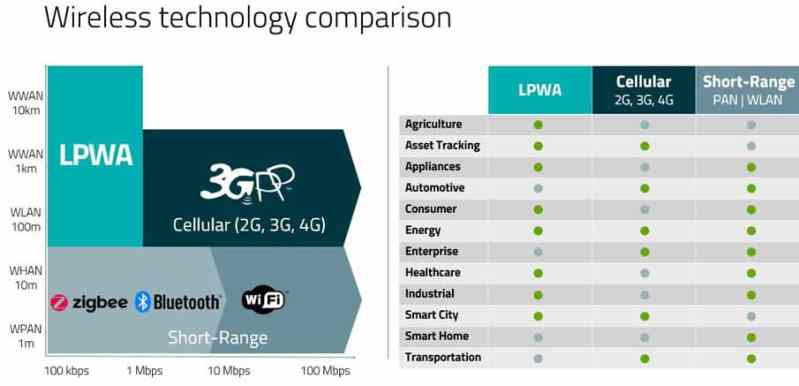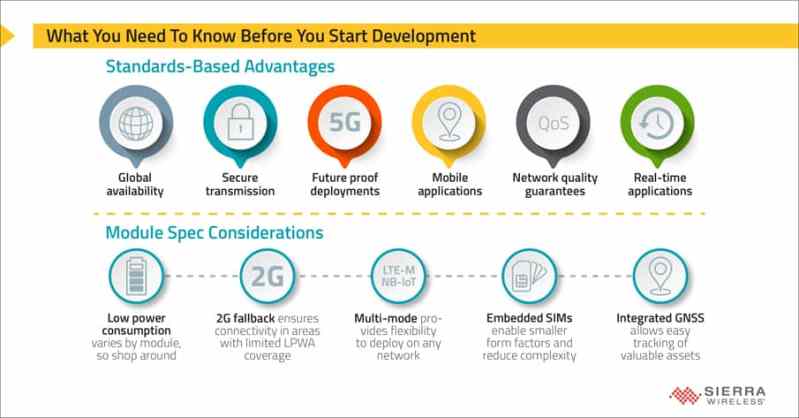January 26, 2018

Related Blogs:
Sign up for blog updates
Get innovation delivered to your inbox. Sign up for our blog and stay on top of the very latest from Semtech (formerly Sierra Wireless).
January 26, 2018

Low Power Wide Area (LPWA) cellular technologies, including LTE-M and NB-IoT, deliver a new class of wireless technology specifically designed for low-power IoT applications. They combine lower cost, broader coverage and better battery life with globally available and secure cellular networks—they’re expected to connect hundreds of millions more things to the Internet in the next few years.
To take advantage of everything that LPWA networks have to offer, you need to select the best technology to connect your application and then find the best module to ensure quick time-to-market and a future-proof deployment.

First, think about whether to use a standards-based or proprietary technology. While proprietary systems can be faster to develop on, standards-based cellular systems offer many more benefits. For example, proprietary systems lack the infrastructure that’s necessary to make a seamless transition to LPWA and cannot guarantee quality of service. Cellular-based systems only need a software update to create a quality-assured LPWA network. Plus, cellular standards-based LPWA provides global coverage that its proprietary counterpart cannot.

In addition to guaranteed quality, easy implementation and global coverage, cellular technology offers better security than proprietary technology, as you can easily encrypt your information. Cellular technology can also support device tracking and guarantees minimum requirements for your system, which is important. The bottom line is, a cellular standards-based technology on LPWA networks will be reliable, easier to scale and provide better long-term availability than a proprietary system, making it the clear choice for most industries.

Once you’ve chosen the right technology, you’ll need to think about which specific modules will help you reach your goals and make the most out of an LTE-M and NB-IoT deployment. The best modules can extend the battery life of your devices, ensure connectivity in areas with limited LPWA coverage, allow you to deploy the same module on worldwide networks and simplify your design and sourcing by integrating SIMs and tracking capabilities.
Save Power
To take full-advantage of LPWA networks’ power-saving features, such as power-saving mode (PSM) and flexible sleep mode (eDRX), you need to understand what’s under the hood of your module. Don’t underestimate the importance of module architecture. A module like Sierra Wireless’ HL78 has been designed to enable new levels of power savings, with improved wake-up and sleep mode responsiveness, as well as ultra-low sleep mode power. This is expected to extend the life of battery operated devices by 5-10X compared to other available LTE-M/NB-IoT modules.
Reliable, Flexible Multi-Mode Coverage
Beyond extending battery life and power efficiency, the best modules also offer more reliable coverage using 2G fallback and multi-mode coverage. A module that supports 2G fallback will be able to ensure that devices stay online, even if LPWAN coverage is poor.
If you select just one technology to deploy on, there’s a good chance that you will run into regions that do not support that technology; network operators often only deploy one LPWA technology at a time. Modules that offer multi-mode coverage, supporting LTE-M and NB-IoT with the same module, give you the flexibility to deploy your application anywhere without having to create multiple product variants for different regions.
Get More in Your Module
Once your power and coverage goals are met, it all comes down to integration and size. Look for a module that packs features like these into the smallest package to get your product to market faster:
A good place to start is Sierra Wireless’ latest HL and WP series modules, which use an industrial-grade common flexible form factor to ensure that IoT systems are scalable. One of the benefits of these modules is that they come in one design that works across any LPWA, 4G, 3G or 2G mobile network. The WP series of modules also includes a dedicated application CPU core running the Linux-based open source Legato application framework to dramatically simplify development. They allow you to build your connected product on one module because you can easily reuse open source code and applications developed with Legato.
Regardless of which module series you ultimately choose, you can rest easy knowing that both fully support LTE-M and NB-IoT and that you can make the absolute most out of these technologies using the power-saving, small form factor and integrated features.
Start with Sierra today to find out more about our HL and WP series LPWA modules for low-power connected products. Our experts can help you decide which module will best fit the needs of your industry and assist you with the implementation process. For more information, watch the webinar, Designing Low-Power Applications for LTE-M and NB-IoT LPWA Networks, and read the whitepaper, LPWA: Fact vs. Fiction.
Get innovation delivered to your inbox. Sign up for our blog and stay on top of the very latest from Semtech (formerly Sierra Wireless).